Analysis of Equality, Diversity, and Inclusion in UK Workplaces
VerifiedAdded on 2022/05/10
|14
|3750
|31
Report
AI Summary
This report examines the definitions and legal frameworks surrounding 'equal opportunities,' 'equality and diversity,' and 'inclusion' in the UK workplace, as defined by the Equality Act 2010 and related government policies. It highlights the responsibilities of leaders and managers within small to medium-sized enterprises (SMEs) in implementing effective Human Resource Management (HRM) strategies and practices. The report analyzes the significance of HRM in SMEs, covering crucial aspects such as HR planning, recruitment and selection, training and development, and performance appraisals. It emphasizes the multiple responsibilities of SME leaders in fostering an inclusive and productive work environment, including aligning HRM strategies with business objectives and addressing the specific needs of employees. The report provides examples of companies like Law Support Group, TRAD Scaffolding Contractors, and Procter & Gamble (P&G) that demonstrate best practices in implementing these policies.
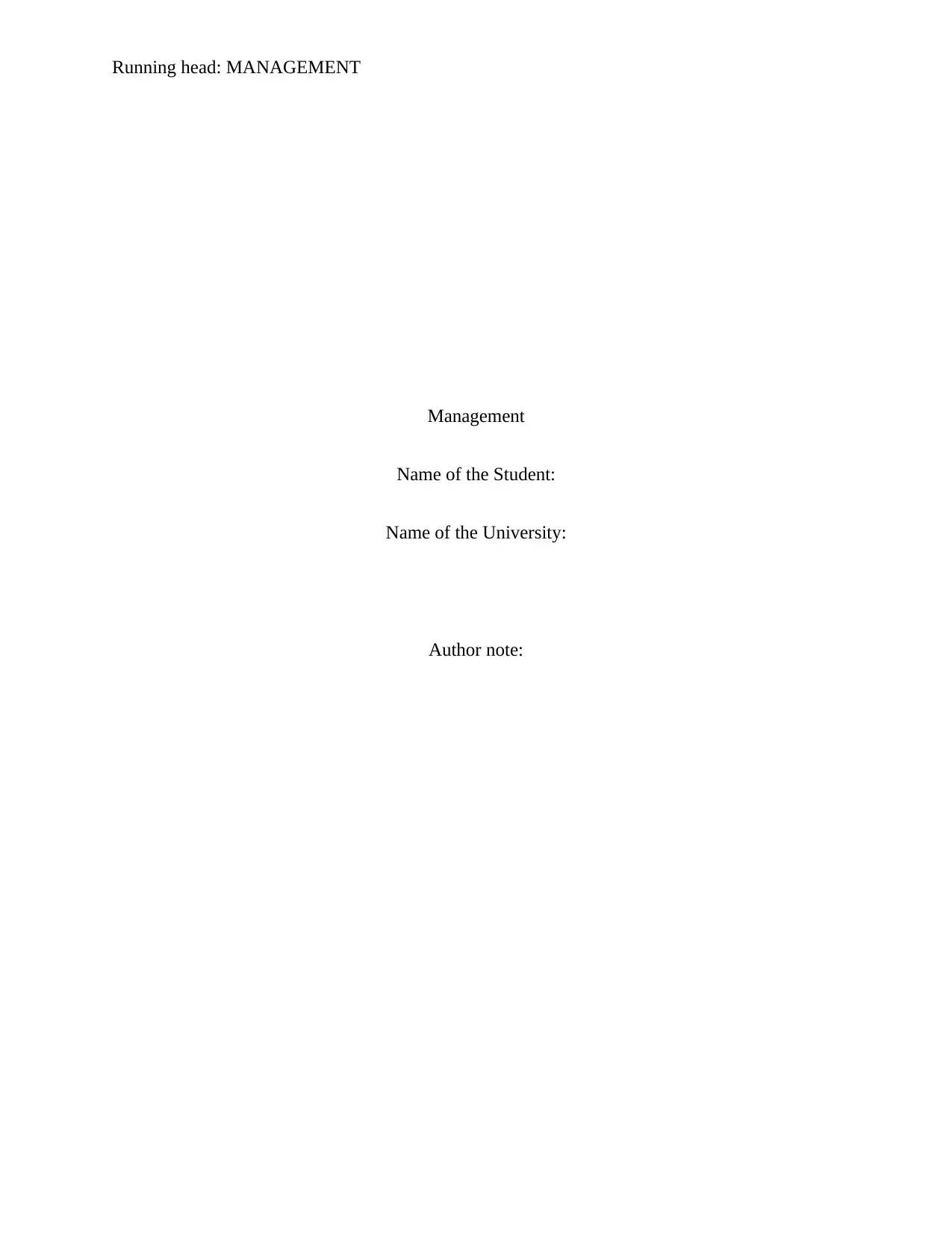
Running head: MANAGEMENT
Management
Name of the Student:
Name of the University:
Author note:
Management
Name of the Student:
Name of the University:
Author note:
Paraphrase This Document
Need a fresh take? Get an instant paraphrase of this document with our AI Paraphraser
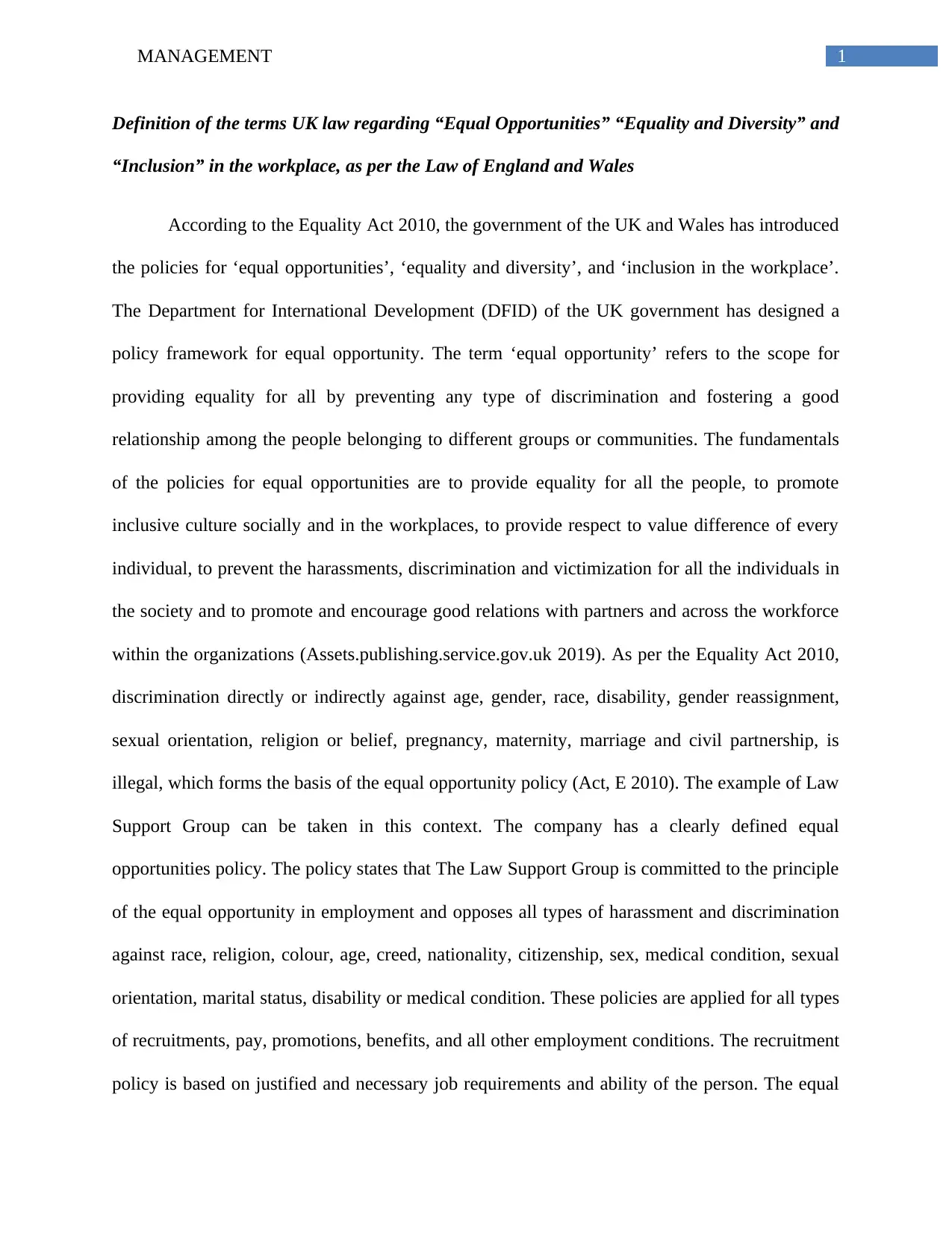
1MANAGEMENT
Definition of the terms UK law regarding “Equal Opportunities” “Equality and Diversity” and
“Inclusion” in the workplace, as per the Law of England and Wales
According to the Equality Act 2010, the government of the UK and Wales has introduced
the policies for ‘equal opportunities’, ‘equality and diversity’, and ‘inclusion in the workplace’.
The Department for International Development (DFID) of the UK government has designed a
policy framework for equal opportunity. The term ‘equal opportunity’ refers to the scope for
providing equality for all by preventing any type of discrimination and fostering a good
relationship among the people belonging to different groups or communities. The fundamentals
of the policies for equal opportunities are to provide equality for all the people, to promote
inclusive culture socially and in the workplaces, to provide respect to value difference of every
individual, to prevent the harassments, discrimination and victimization for all the individuals in
the society and to promote and encourage good relations with partners and across the workforce
within the organizations (Assets.publishing.service.gov.uk 2019). As per the Equality Act 2010,
discrimination directly or indirectly against age, gender, race, disability, gender reassignment,
sexual orientation, religion or belief, pregnancy, maternity, marriage and civil partnership, is
illegal, which forms the basis of the equal opportunity policy (Act, E 2010). The example of Law
Support Group can be taken in this context. The company has a clearly defined equal
opportunities policy. The policy states that The Law Support Group is committed to the principle
of the equal opportunity in employment and opposes all types of harassment and discrimination
against race, religion, colour, age, creed, nationality, citizenship, sex, medical condition, sexual
orientation, marital status, disability or medical condition. These policies are applied for all types
of recruitments, pay, promotions, benefits, and all other employment conditions. The recruitment
policy is based on justified and necessary job requirements and ability of the person. The equal
Definition of the terms UK law regarding “Equal Opportunities” “Equality and Diversity” and
“Inclusion” in the workplace, as per the Law of England and Wales
According to the Equality Act 2010, the government of the UK and Wales has introduced
the policies for ‘equal opportunities’, ‘equality and diversity’, and ‘inclusion in the workplace’.
The Department for International Development (DFID) of the UK government has designed a
policy framework for equal opportunity. The term ‘equal opportunity’ refers to the scope for
providing equality for all by preventing any type of discrimination and fostering a good
relationship among the people belonging to different groups or communities. The fundamentals
of the policies for equal opportunities are to provide equality for all the people, to promote
inclusive culture socially and in the workplaces, to provide respect to value difference of every
individual, to prevent the harassments, discrimination and victimization for all the individuals in
the society and to promote and encourage good relations with partners and across the workforce
within the organizations (Assets.publishing.service.gov.uk 2019). As per the Equality Act 2010,
discrimination directly or indirectly against age, gender, race, disability, gender reassignment,
sexual orientation, religion or belief, pregnancy, maternity, marriage and civil partnership, is
illegal, which forms the basis of the equal opportunity policy (Act, E 2010). The example of Law
Support Group can be taken in this context. The company has a clearly defined equal
opportunities policy. The policy states that The Law Support Group is committed to the principle
of the equal opportunity in employment and opposes all types of harassment and discrimination
against race, religion, colour, age, creed, nationality, citizenship, sex, medical condition, sexual
orientation, marital status, disability or medical condition. These policies are applied for all types
of recruitments, pay, promotions, benefits, and all other employment conditions. The recruitment
policy is based on justified and necessary job requirements and ability of the person. The equal
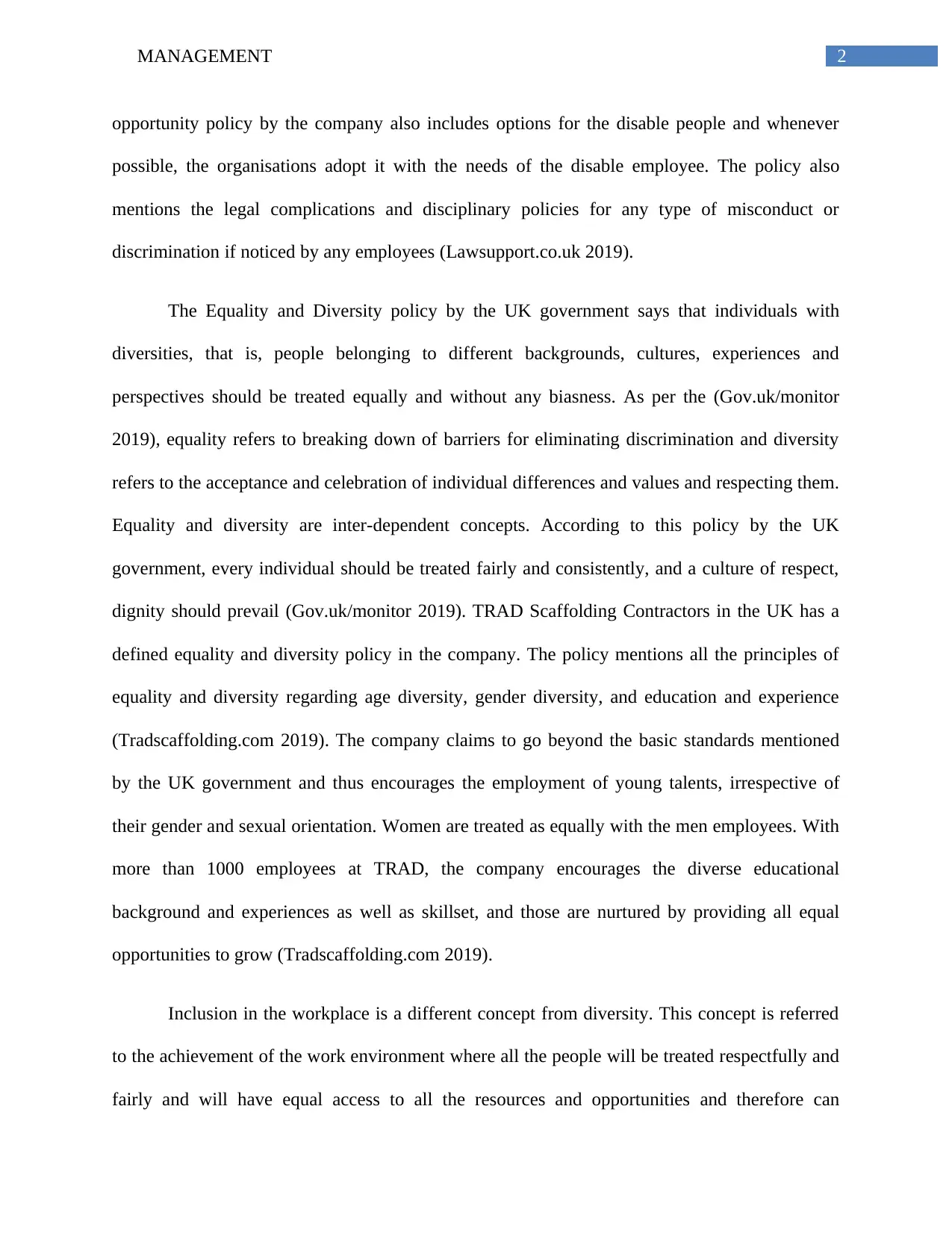
2MANAGEMENT
opportunity policy by the company also includes options for the disable people and whenever
possible, the organisations adopt it with the needs of the disable employee. The policy also
mentions the legal complications and disciplinary policies for any type of misconduct or
discrimination if noticed by any employees (Lawsupport.co.uk 2019).
The Equality and Diversity policy by the UK government says that individuals with
diversities, that is, people belonging to different backgrounds, cultures, experiences and
perspectives should be treated equally and without any biasness. As per the (Gov.uk/monitor
2019), equality refers to breaking down of barriers for eliminating discrimination and diversity
refers to the acceptance and celebration of individual differences and values and respecting them.
Equality and diversity are inter-dependent concepts. According to this policy by the UK
government, every individual should be treated fairly and consistently, and a culture of respect,
dignity should prevail (Gov.uk/monitor 2019). TRAD Scaffolding Contractors in the UK has a
defined equality and diversity policy in the company. The policy mentions all the principles of
equality and diversity regarding age diversity, gender diversity, and education and experience
(Tradscaffolding.com 2019). The company claims to go beyond the basic standards mentioned
by the UK government and thus encourages the employment of young talents, irrespective of
their gender and sexual orientation. Women are treated as equally with the men employees. With
more than 1000 employees at TRAD, the company encourages the diverse educational
background and experiences as well as skillset, and those are nurtured by providing all equal
opportunities to grow (Tradscaffolding.com 2019).
Inclusion in the workplace is a different concept from diversity. This concept is referred
to the achievement of the work environment where all the people will be treated respectfully and
fairly and will have equal access to all the resources and opportunities and therefore can
opportunity policy by the company also includes options for the disable people and whenever
possible, the organisations adopt it with the needs of the disable employee. The policy also
mentions the legal complications and disciplinary policies for any type of misconduct or
discrimination if noticed by any employees (Lawsupport.co.uk 2019).
The Equality and Diversity policy by the UK government says that individuals with
diversities, that is, people belonging to different backgrounds, cultures, experiences and
perspectives should be treated equally and without any biasness. As per the (Gov.uk/monitor
2019), equality refers to breaking down of barriers for eliminating discrimination and diversity
refers to the acceptance and celebration of individual differences and values and respecting them.
Equality and diversity are inter-dependent concepts. According to this policy by the UK
government, every individual should be treated fairly and consistently, and a culture of respect,
dignity should prevail (Gov.uk/monitor 2019). TRAD Scaffolding Contractors in the UK has a
defined equality and diversity policy in the company. The policy mentions all the principles of
equality and diversity regarding age diversity, gender diversity, and education and experience
(Tradscaffolding.com 2019). The company claims to go beyond the basic standards mentioned
by the UK government and thus encourages the employment of young talents, irrespective of
their gender and sexual orientation. Women are treated as equally with the men employees. With
more than 1000 employees at TRAD, the company encourages the diverse educational
background and experiences as well as skillset, and those are nurtured by providing all equal
opportunities to grow (Tradscaffolding.com 2019).
Inclusion in the workplace is a different concept from diversity. This concept is referred
to the achievement of the work environment where all the people will be treated respectfully and
fairly and will have equal access to all the resources and opportunities and therefore can
⊘ This is a preview!⊘
Do you want full access?
Subscribe today to unlock all pages.

Trusted by 1+ million students worldwide
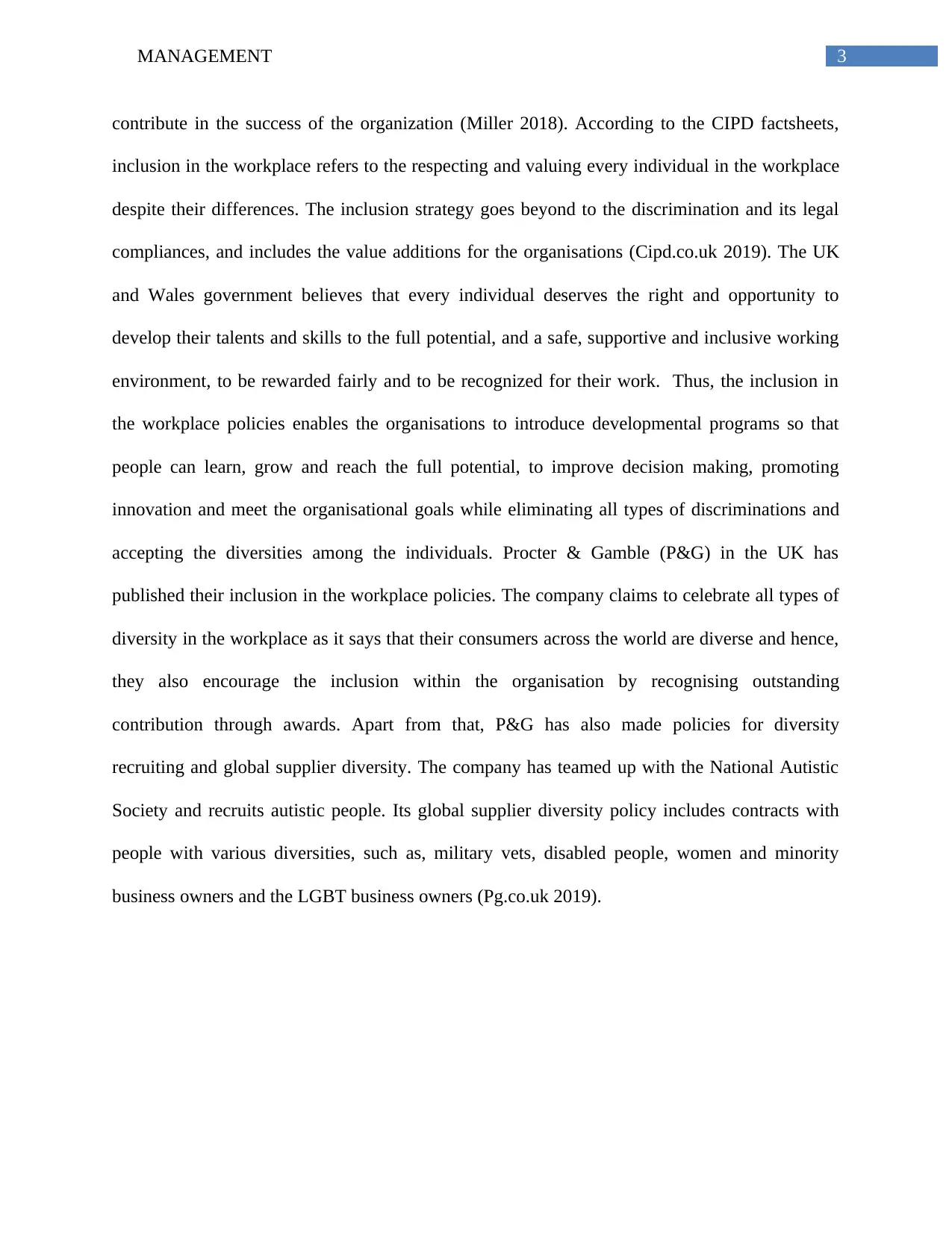
3MANAGEMENT
contribute in the success of the organization (Miller 2018). According to the CIPD factsheets,
inclusion in the workplace refers to the respecting and valuing every individual in the workplace
despite their differences. The inclusion strategy goes beyond to the discrimination and its legal
compliances, and includes the value additions for the organisations (Cipd.co.uk 2019). The UK
and Wales government believes that every individual deserves the right and opportunity to
develop their talents and skills to the full potential, and a safe, supportive and inclusive working
environment, to be rewarded fairly and to be recognized for their work. Thus, the inclusion in
the workplace policies enables the organisations to introduce developmental programs so that
people can learn, grow and reach the full potential, to improve decision making, promoting
innovation and meet the organisational goals while eliminating all types of discriminations and
accepting the diversities among the individuals. Procter & Gamble (P&G) in the UK has
published their inclusion in the workplace policies. The company claims to celebrate all types of
diversity in the workplace as it says that their consumers across the world are diverse and hence,
they also encourage the inclusion within the organisation by recognising outstanding
contribution through awards. Apart from that, P&G has also made policies for diversity
recruiting and global supplier diversity. The company has teamed up with the National Autistic
Society and recruits autistic people. Its global supplier diversity policy includes contracts with
people with various diversities, such as, military vets, disabled people, women and minority
business owners and the LGBT business owners (Pg.co.uk 2019).
contribute in the success of the organization (Miller 2018). According to the CIPD factsheets,
inclusion in the workplace refers to the respecting and valuing every individual in the workplace
despite their differences. The inclusion strategy goes beyond to the discrimination and its legal
compliances, and includes the value additions for the organisations (Cipd.co.uk 2019). The UK
and Wales government believes that every individual deserves the right and opportunity to
develop their talents and skills to the full potential, and a safe, supportive and inclusive working
environment, to be rewarded fairly and to be recognized for their work. Thus, the inclusion in
the workplace policies enables the organisations to introduce developmental programs so that
people can learn, grow and reach the full potential, to improve decision making, promoting
innovation and meet the organisational goals while eliminating all types of discriminations and
accepting the diversities among the individuals. Procter & Gamble (P&G) in the UK has
published their inclusion in the workplace policies. The company claims to celebrate all types of
diversity in the workplace as it says that their consumers across the world are diverse and hence,
they also encourage the inclusion within the organisation by recognising outstanding
contribution through awards. Apart from that, P&G has also made policies for diversity
recruiting and global supplier diversity. The company has teamed up with the National Autistic
Society and recruits autistic people. Its global supplier diversity policy includes contracts with
people with various diversities, such as, military vets, disabled people, women and minority
business owners and the LGBT business owners (Pg.co.uk 2019).
Paraphrase This Document
Need a fresh take? Get an instant paraphrase of this document with our AI Paraphraser
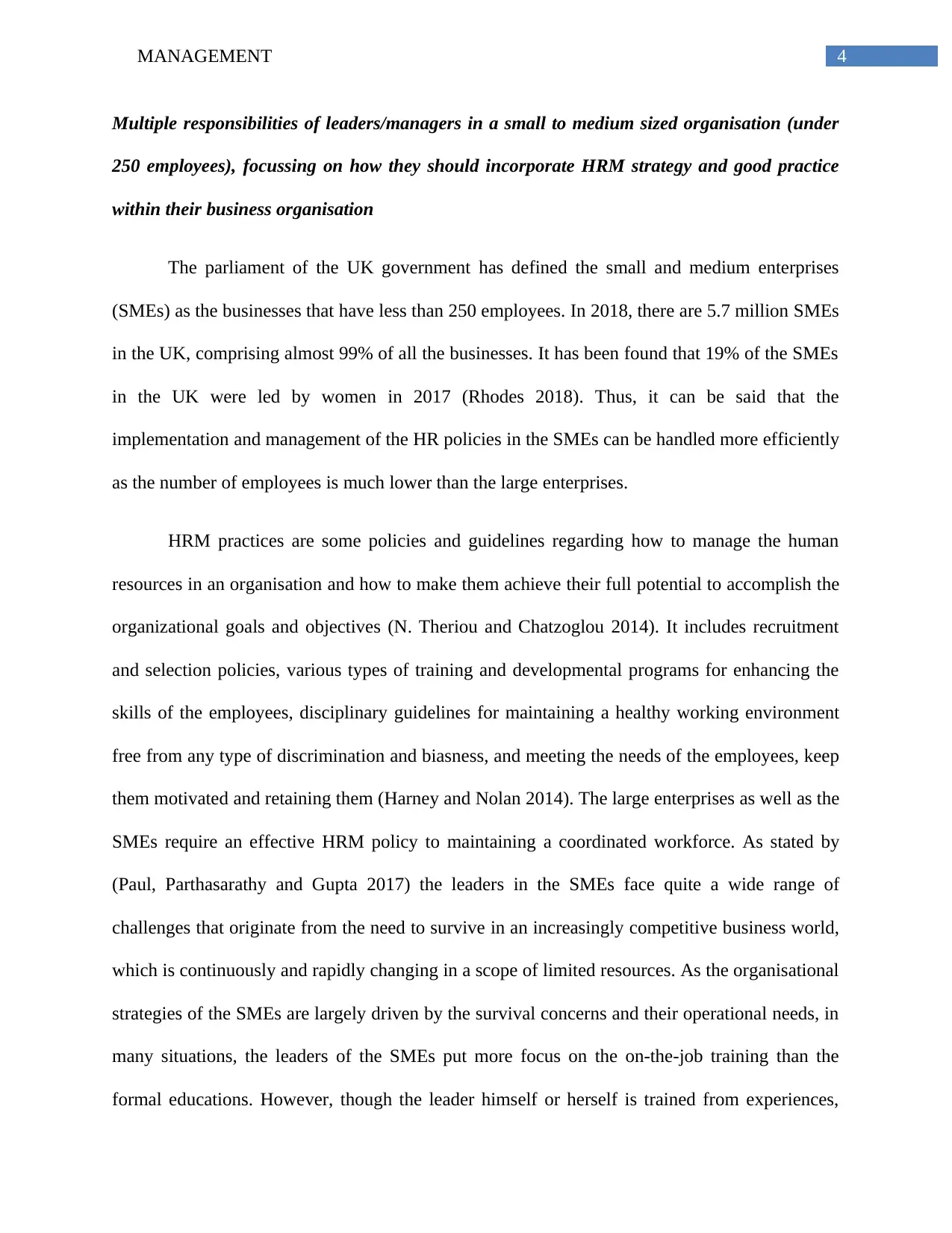
4MANAGEMENT
Multiple responsibilities of leaders/managers in a small to medium sized organisation (under
250 employees), focussing on how they should incorporate HRM strategy and good practice
within their business organisation
The parliament of the UK government has defined the small and medium enterprises
(SMEs) as the businesses that have less than 250 employees. In 2018, there are 5.7 million SMEs
in the UK, comprising almost 99% of all the businesses. It has been found that 19% of the SMEs
in the UK were led by women in 2017 (Rhodes 2018). Thus, it can be said that the
implementation and management of the HR policies in the SMEs can be handled more efficiently
as the number of employees is much lower than the large enterprises.
HRM practices are some policies and guidelines regarding how to manage the human
resources in an organisation and how to make them achieve their full potential to accomplish the
organizational goals and objectives (N. Theriou and Chatzoglou 2014). It includes recruitment
and selection policies, various types of training and developmental programs for enhancing the
skills of the employees, disciplinary guidelines for maintaining a healthy working environment
free from any type of discrimination and biasness, and meeting the needs of the employees, keep
them motivated and retaining them (Harney and Nolan 2014). The large enterprises as well as the
SMEs require an effective HRM policy to maintaining a coordinated workforce. As stated by
(Paul, Parthasarathy and Gupta 2017) the leaders in the SMEs face quite a wide range of
challenges that originate from the need to survive in an increasingly competitive business world,
which is continuously and rapidly changing in a scope of limited resources. As the organisational
strategies of the SMEs are largely driven by the survival concerns and their operational needs, in
many situations, the leaders of the SMEs put more focus on the on-the-job training than the
formal educations. However, though the leader himself or herself is trained from experiences,
Multiple responsibilities of leaders/managers in a small to medium sized organisation (under
250 employees), focussing on how they should incorporate HRM strategy and good practice
within their business organisation
The parliament of the UK government has defined the small and medium enterprises
(SMEs) as the businesses that have less than 250 employees. In 2018, there are 5.7 million SMEs
in the UK, comprising almost 99% of all the businesses. It has been found that 19% of the SMEs
in the UK were led by women in 2017 (Rhodes 2018). Thus, it can be said that the
implementation and management of the HR policies in the SMEs can be handled more efficiently
as the number of employees is much lower than the large enterprises.
HRM practices are some policies and guidelines regarding how to manage the human
resources in an organisation and how to make them achieve their full potential to accomplish the
organizational goals and objectives (N. Theriou and Chatzoglou 2014). It includes recruitment
and selection policies, various types of training and developmental programs for enhancing the
skills of the employees, disciplinary guidelines for maintaining a healthy working environment
free from any type of discrimination and biasness, and meeting the needs of the employees, keep
them motivated and retaining them (Harney and Nolan 2014). The large enterprises as well as the
SMEs require an effective HRM policy to maintaining a coordinated workforce. As stated by
(Paul, Parthasarathy and Gupta 2017) the leaders in the SMEs face quite a wide range of
challenges that originate from the need to survive in an increasingly competitive business world,
which is continuously and rapidly changing in a scope of limited resources. As the organisational
strategies of the SMEs are largely driven by the survival concerns and their operational needs, in
many situations, the leaders of the SMEs put more focus on the on-the-job training than the
formal educations. However, though the leader himself or herself is trained from experiences,
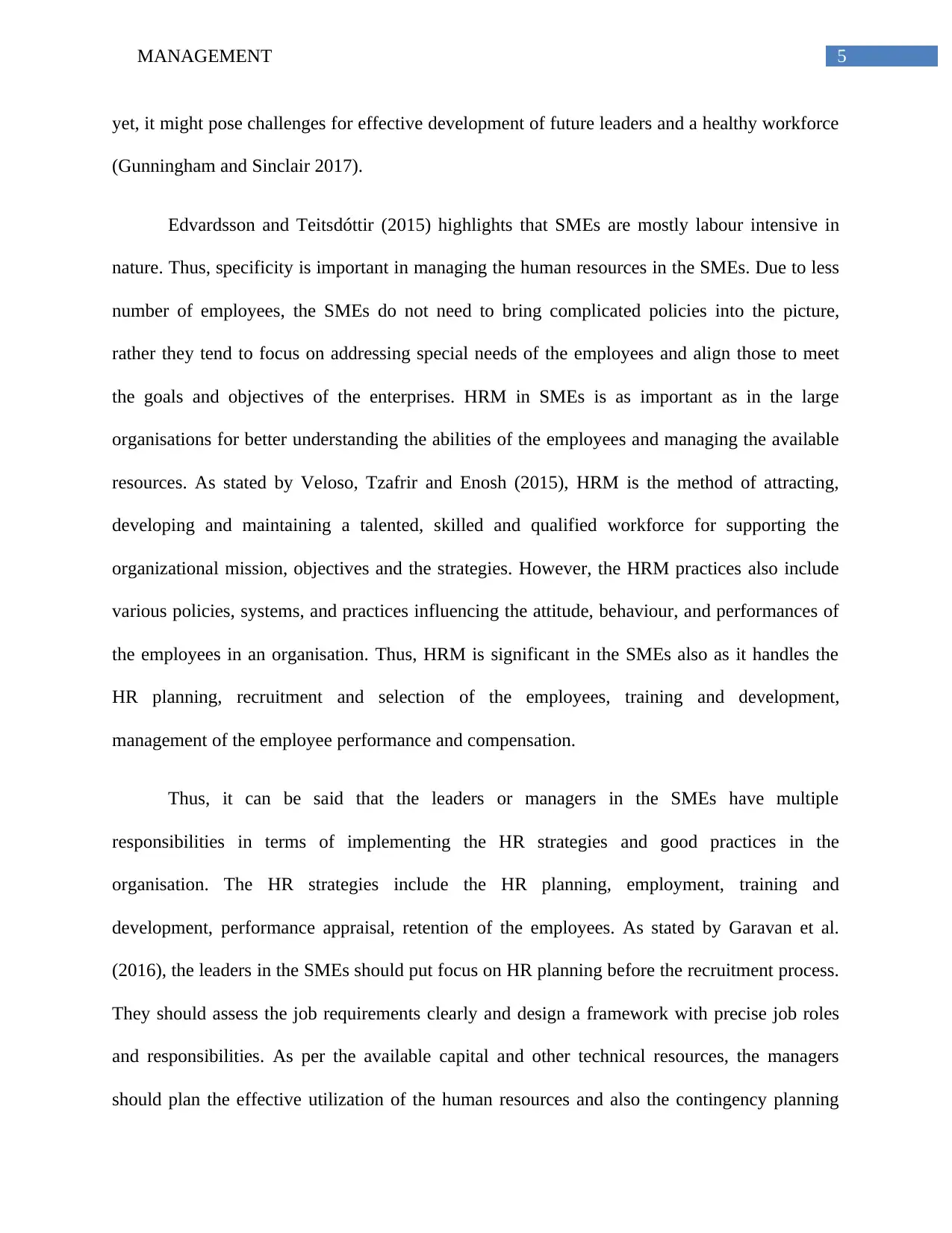
5MANAGEMENT
yet, it might pose challenges for effective development of future leaders and a healthy workforce
(Gunningham and Sinclair 2017).
Edvardsson and Teitsdóttir (2015) highlights that SMEs are mostly labour intensive in
nature. Thus, specificity is important in managing the human resources in the SMEs. Due to less
number of employees, the SMEs do not need to bring complicated policies into the picture,
rather they tend to focus on addressing special needs of the employees and align those to meet
the goals and objectives of the enterprises. HRM in SMEs is as important as in the large
organisations for better understanding the abilities of the employees and managing the available
resources. As stated by Veloso, Tzafrir and Enosh (2015), HRM is the method of attracting,
developing and maintaining a talented, skilled and qualified workforce for supporting the
organizational mission, objectives and the strategies. However, the HRM practices also include
various policies, systems, and practices influencing the attitude, behaviour, and performances of
the employees in an organisation. Thus, HRM is significant in the SMEs also as it handles the
HR planning, recruitment and selection of the employees, training and development,
management of the employee performance and compensation.
Thus, it can be said that the leaders or managers in the SMEs have multiple
responsibilities in terms of implementing the HR strategies and good practices in the
organisation. The HR strategies include the HR planning, employment, training and
development, performance appraisal, retention of the employees. As stated by Garavan et al.
(2016), the leaders in the SMEs should put focus on HR planning before the recruitment process.
They should assess the job requirements clearly and design a framework with precise job roles
and responsibilities. As per the available capital and other technical resources, the managers
should plan the effective utilization of the human resources and also the contingency planning
yet, it might pose challenges for effective development of future leaders and a healthy workforce
(Gunningham and Sinclair 2017).
Edvardsson and Teitsdóttir (2015) highlights that SMEs are mostly labour intensive in
nature. Thus, specificity is important in managing the human resources in the SMEs. Due to less
number of employees, the SMEs do not need to bring complicated policies into the picture,
rather they tend to focus on addressing special needs of the employees and align those to meet
the goals and objectives of the enterprises. HRM in SMEs is as important as in the large
organisations for better understanding the abilities of the employees and managing the available
resources. As stated by Veloso, Tzafrir and Enosh (2015), HRM is the method of attracting,
developing and maintaining a talented, skilled and qualified workforce for supporting the
organizational mission, objectives and the strategies. However, the HRM practices also include
various policies, systems, and practices influencing the attitude, behaviour, and performances of
the employees in an organisation. Thus, HRM is significant in the SMEs also as it handles the
HR planning, recruitment and selection of the employees, training and development,
management of the employee performance and compensation.
Thus, it can be said that the leaders or managers in the SMEs have multiple
responsibilities in terms of implementing the HR strategies and good practices in the
organisation. The HR strategies include the HR planning, employment, training and
development, performance appraisal, retention of the employees. As stated by Garavan et al.
(2016), the leaders in the SMEs should put focus on HR planning before the recruitment process.
They should assess the job requirements clearly and design a framework with precise job roles
and responsibilities. As per the available capital and other technical resources, the managers
should plan the effective utilization of the human resources and also the contingency planning
⊘ This is a preview!⊘
Do you want full access?
Subscribe today to unlock all pages.

Trusted by 1+ million students worldwide
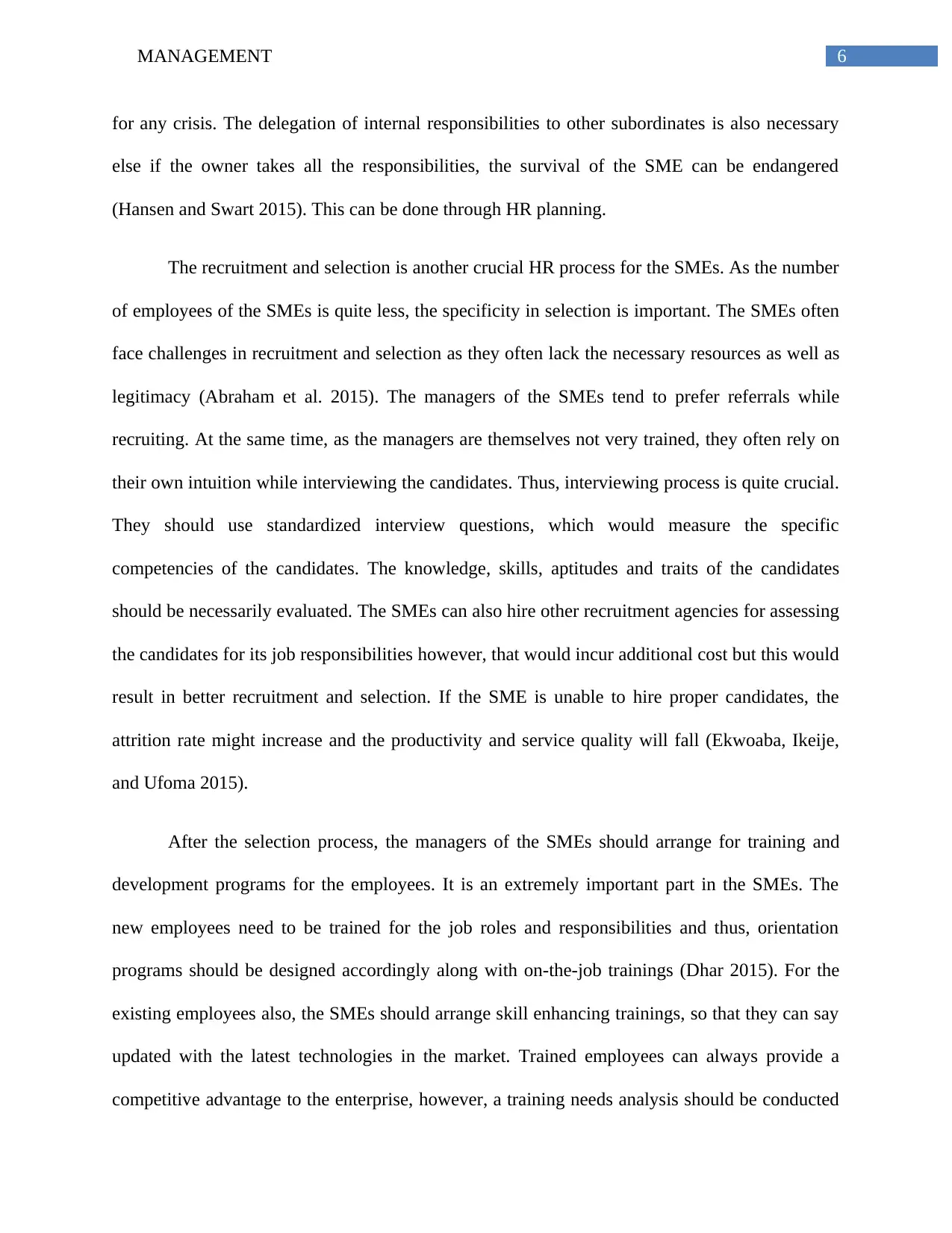
6MANAGEMENT
for any crisis. The delegation of internal responsibilities to other subordinates is also necessary
else if the owner takes all the responsibilities, the survival of the SME can be endangered
(Hansen and Swart 2015). This can be done through HR planning.
The recruitment and selection is another crucial HR process for the SMEs. As the number
of employees of the SMEs is quite less, the specificity in selection is important. The SMEs often
face challenges in recruitment and selection as they often lack the necessary resources as well as
legitimacy (Abraham et al. 2015). The managers of the SMEs tend to prefer referrals while
recruiting. At the same time, as the managers are themselves not very trained, they often rely on
their own intuition while interviewing the candidates. Thus, interviewing process is quite crucial.
They should use standardized interview questions, which would measure the specific
competencies of the candidates. The knowledge, skills, aptitudes and traits of the candidates
should be necessarily evaluated. The SMEs can also hire other recruitment agencies for assessing
the candidates for its job responsibilities however, that would incur additional cost but this would
result in better recruitment and selection. If the SME is unable to hire proper candidates, the
attrition rate might increase and the productivity and service quality will fall (Ekwoaba, Ikeije,
and Ufoma 2015).
After the selection process, the managers of the SMEs should arrange for training and
development programs for the employees. It is an extremely important part in the SMEs. The
new employees need to be trained for the job roles and responsibilities and thus, orientation
programs should be designed accordingly along with on-the-job trainings (Dhar 2015). For the
existing employees also, the SMEs should arrange skill enhancing trainings, so that they can say
updated with the latest technologies in the market. Trained employees can always provide a
competitive advantage to the enterprise, however, a training needs analysis should be conducted
for any crisis. The delegation of internal responsibilities to other subordinates is also necessary
else if the owner takes all the responsibilities, the survival of the SME can be endangered
(Hansen and Swart 2015). This can be done through HR planning.
The recruitment and selection is another crucial HR process for the SMEs. As the number
of employees of the SMEs is quite less, the specificity in selection is important. The SMEs often
face challenges in recruitment and selection as they often lack the necessary resources as well as
legitimacy (Abraham et al. 2015). The managers of the SMEs tend to prefer referrals while
recruiting. At the same time, as the managers are themselves not very trained, they often rely on
their own intuition while interviewing the candidates. Thus, interviewing process is quite crucial.
They should use standardized interview questions, which would measure the specific
competencies of the candidates. The knowledge, skills, aptitudes and traits of the candidates
should be necessarily evaluated. The SMEs can also hire other recruitment agencies for assessing
the candidates for its job responsibilities however, that would incur additional cost but this would
result in better recruitment and selection. If the SME is unable to hire proper candidates, the
attrition rate might increase and the productivity and service quality will fall (Ekwoaba, Ikeije,
and Ufoma 2015).
After the selection process, the managers of the SMEs should arrange for training and
development programs for the employees. It is an extremely important part in the SMEs. The
new employees need to be trained for the job roles and responsibilities and thus, orientation
programs should be designed accordingly along with on-the-job trainings (Dhar 2015). For the
existing employees also, the SMEs should arrange skill enhancing trainings, so that they can say
updated with the latest technologies in the market. Trained employees can always provide a
competitive advantage to the enterprise, however, a training needs analysis should be conducted
Paraphrase This Document
Need a fresh take? Get an instant paraphrase of this document with our AI Paraphraser
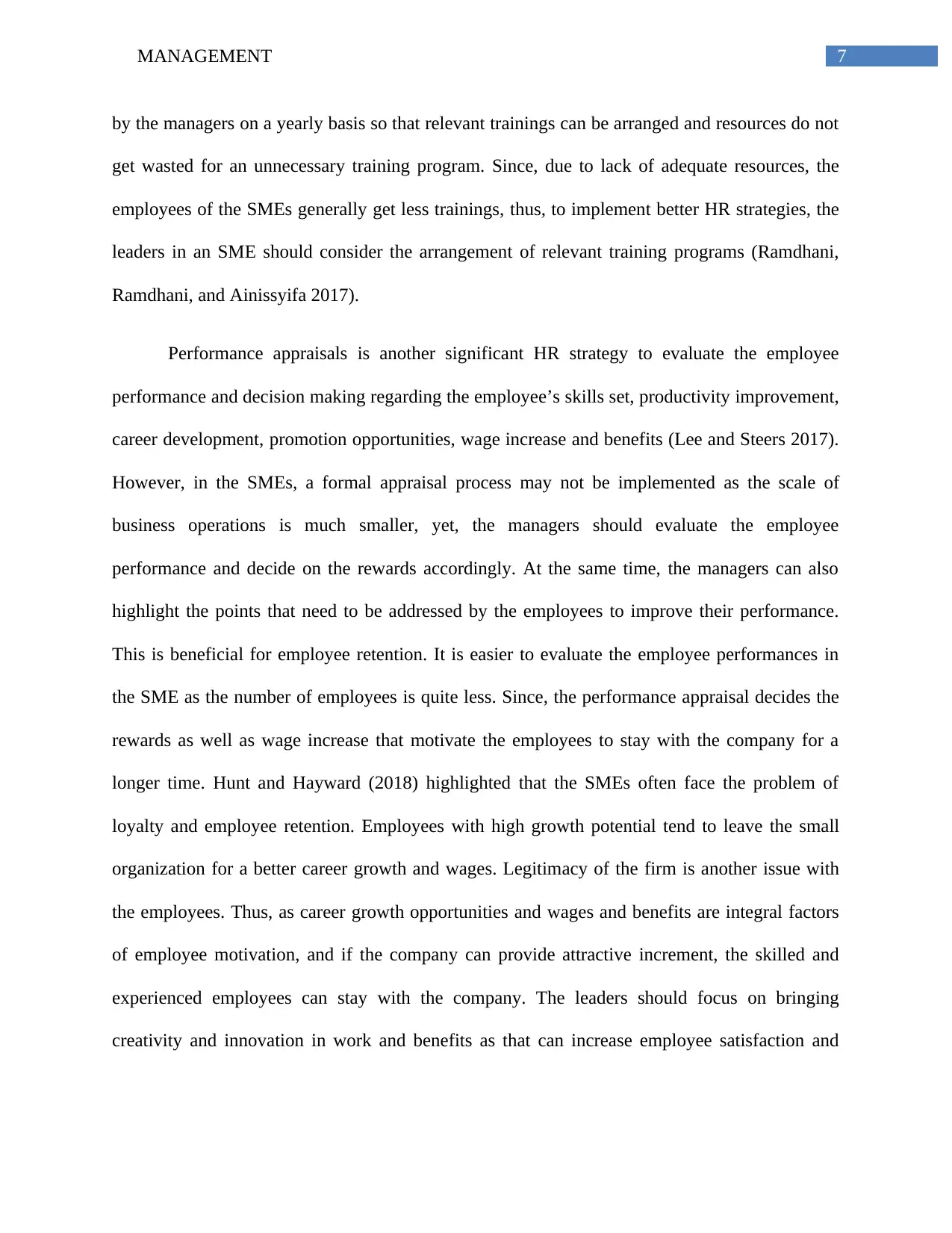
7MANAGEMENT
by the managers on a yearly basis so that relevant trainings can be arranged and resources do not
get wasted for an unnecessary training program. Since, due to lack of adequate resources, the
employees of the SMEs generally get less trainings, thus, to implement better HR strategies, the
leaders in an SME should consider the arrangement of relevant training programs (Ramdhani,
Ramdhani, and Ainissyifa 2017).
Performance appraisals is another significant HR strategy to evaluate the employee
performance and decision making regarding the employee’s skills set, productivity improvement,
career development, promotion opportunities, wage increase and benefits (Lee and Steers 2017).
However, in the SMEs, a formal appraisal process may not be implemented as the scale of
business operations is much smaller, yet, the managers should evaluate the employee
performance and decide on the rewards accordingly. At the same time, the managers can also
highlight the points that need to be addressed by the employees to improve their performance.
This is beneficial for employee retention. It is easier to evaluate the employee performances in
the SME as the number of employees is quite less. Since, the performance appraisal decides the
rewards as well as wage increase that motivate the employees to stay with the company for a
longer time. Hunt and Hayward (2018) highlighted that the SMEs often face the problem of
loyalty and employee retention. Employees with high growth potential tend to leave the small
organization for a better career growth and wages. Legitimacy of the firm is another issue with
the employees. Thus, as career growth opportunities and wages and benefits are integral factors
of employee motivation, and if the company can provide attractive increment, the skilled and
experienced employees can stay with the company. The leaders should focus on bringing
creativity and innovation in work and benefits as that can increase employee satisfaction and
by the managers on a yearly basis so that relevant trainings can be arranged and resources do not
get wasted for an unnecessary training program. Since, due to lack of adequate resources, the
employees of the SMEs generally get less trainings, thus, to implement better HR strategies, the
leaders in an SME should consider the arrangement of relevant training programs (Ramdhani,
Ramdhani, and Ainissyifa 2017).
Performance appraisals is another significant HR strategy to evaluate the employee
performance and decision making regarding the employee’s skills set, productivity improvement,
career development, promotion opportunities, wage increase and benefits (Lee and Steers 2017).
However, in the SMEs, a formal appraisal process may not be implemented as the scale of
business operations is much smaller, yet, the managers should evaluate the employee
performance and decide on the rewards accordingly. At the same time, the managers can also
highlight the points that need to be addressed by the employees to improve their performance.
This is beneficial for employee retention. It is easier to evaluate the employee performances in
the SME as the number of employees is quite less. Since, the performance appraisal decides the
rewards as well as wage increase that motivate the employees to stay with the company for a
longer time. Hunt and Hayward (2018) highlighted that the SMEs often face the problem of
loyalty and employee retention. Employees with high growth potential tend to leave the small
organization for a better career growth and wages. Legitimacy of the firm is another issue with
the employees. Thus, as career growth opportunities and wages and benefits are integral factors
of employee motivation, and if the company can provide attractive increment, the skilled and
experienced employees can stay with the company. The leaders should focus on bringing
creativity and innovation in work and benefits as that can increase employee satisfaction and
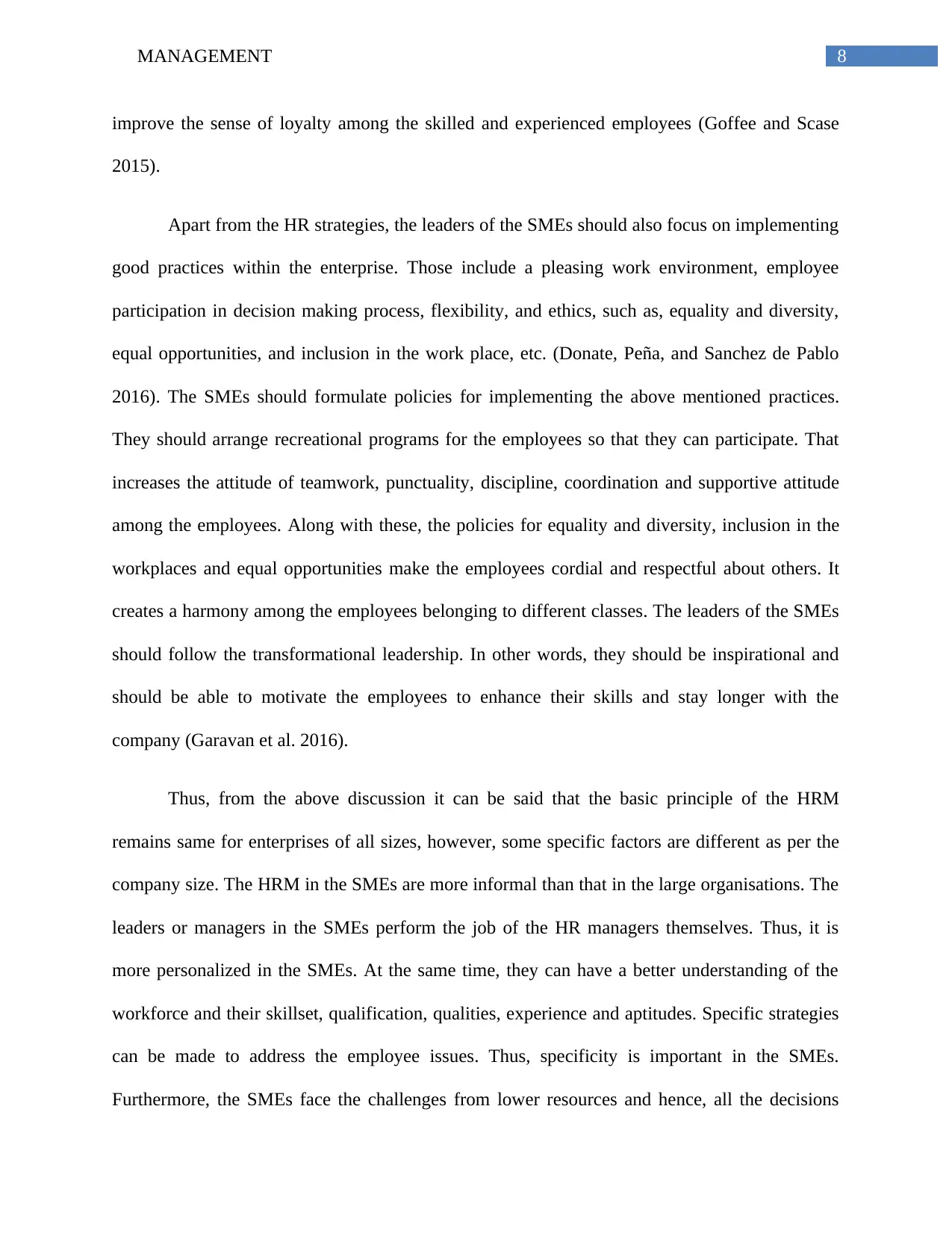
8MANAGEMENT
improve the sense of loyalty among the skilled and experienced employees (Goffee and Scase
2015).
Apart from the HR strategies, the leaders of the SMEs should also focus on implementing
good practices within the enterprise. Those include a pleasing work environment, employee
participation in decision making process, flexibility, and ethics, such as, equality and diversity,
equal opportunities, and inclusion in the work place, etc. (Donate, Peña, and Sanchez de Pablo
2016). The SMEs should formulate policies for implementing the above mentioned practices.
They should arrange recreational programs for the employees so that they can participate. That
increases the attitude of teamwork, punctuality, discipline, coordination and supportive attitude
among the employees. Along with these, the policies for equality and diversity, inclusion in the
workplaces and equal opportunities make the employees cordial and respectful about others. It
creates a harmony among the employees belonging to different classes. The leaders of the SMEs
should follow the transformational leadership. In other words, they should be inspirational and
should be able to motivate the employees to enhance their skills and stay longer with the
company (Garavan et al. 2016).
Thus, from the above discussion it can be said that the basic principle of the HRM
remains same for enterprises of all sizes, however, some specific factors are different as per the
company size. The HRM in the SMEs are more informal than that in the large organisations. The
leaders or managers in the SMEs perform the job of the HR managers themselves. Thus, it is
more personalized in the SMEs. At the same time, they can have a better understanding of the
workforce and their skillset, qualification, qualities, experience and aptitudes. Specific strategies
can be made to address the employee issues. Thus, specificity is important in the SMEs.
Furthermore, the SMEs face the challenges from lower resources and hence, all the decisions
improve the sense of loyalty among the skilled and experienced employees (Goffee and Scase
2015).
Apart from the HR strategies, the leaders of the SMEs should also focus on implementing
good practices within the enterprise. Those include a pleasing work environment, employee
participation in decision making process, flexibility, and ethics, such as, equality and diversity,
equal opportunities, and inclusion in the work place, etc. (Donate, Peña, and Sanchez de Pablo
2016). The SMEs should formulate policies for implementing the above mentioned practices.
They should arrange recreational programs for the employees so that they can participate. That
increases the attitude of teamwork, punctuality, discipline, coordination and supportive attitude
among the employees. Along with these, the policies for equality and diversity, inclusion in the
workplaces and equal opportunities make the employees cordial and respectful about others. It
creates a harmony among the employees belonging to different classes. The leaders of the SMEs
should follow the transformational leadership. In other words, they should be inspirational and
should be able to motivate the employees to enhance their skills and stay longer with the
company (Garavan et al. 2016).
Thus, from the above discussion it can be said that the basic principle of the HRM
remains same for enterprises of all sizes, however, some specific factors are different as per the
company size. The HRM in the SMEs are more informal than that in the large organisations. The
leaders or managers in the SMEs perform the job of the HR managers themselves. Thus, it is
more personalized in the SMEs. At the same time, they can have a better understanding of the
workforce and their skillset, qualification, qualities, experience and aptitudes. Specific strategies
can be made to address the employee issues. Thus, specificity is important in the SMEs.
Furthermore, the SMEs face the challenges from lower resources and hence, all the decisions
⊘ This is a preview!⊘
Do you want full access?
Subscribe today to unlock all pages.

Trusted by 1+ million students worldwide
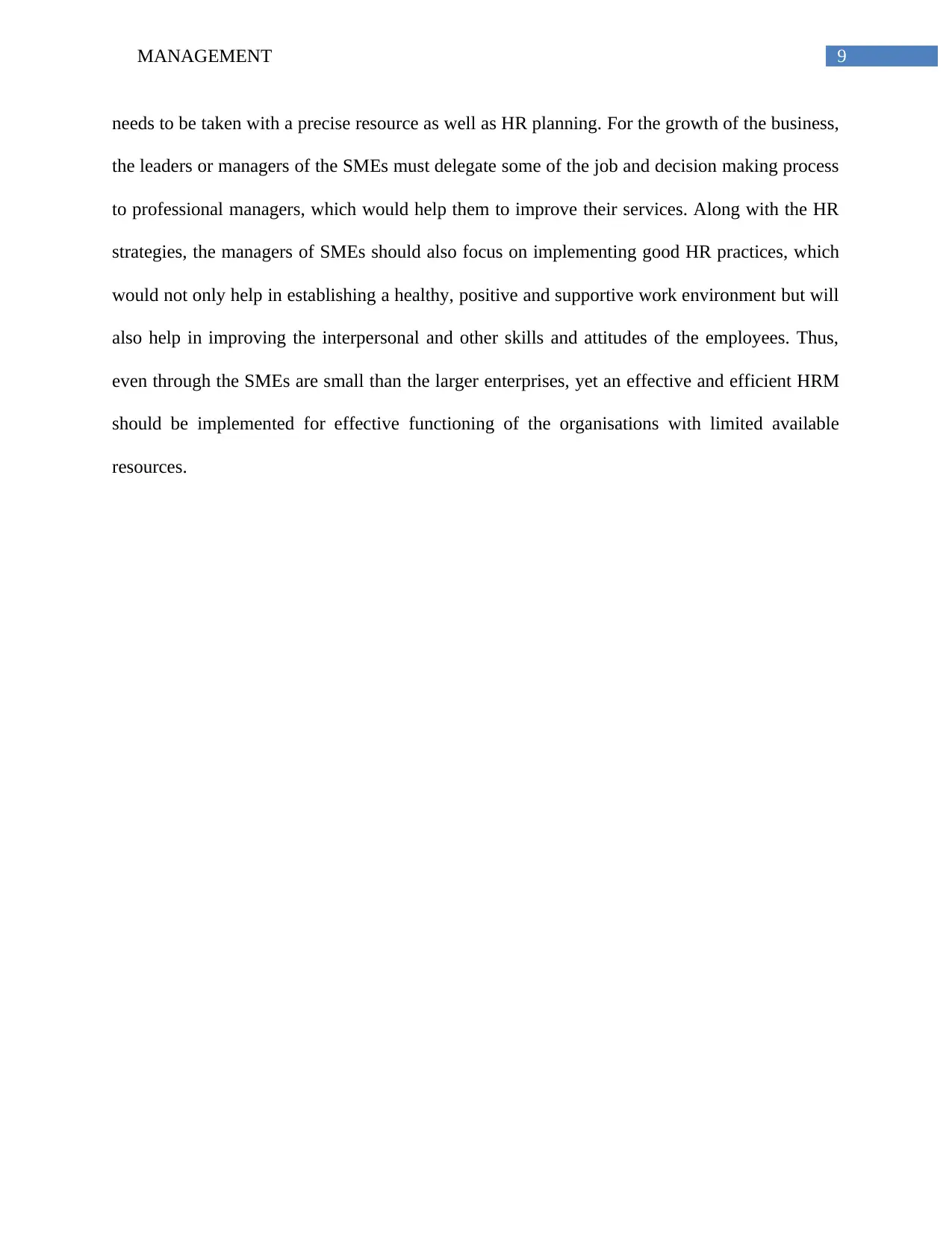
9MANAGEMENT
needs to be taken with a precise resource as well as HR planning. For the growth of the business,
the leaders or managers of the SMEs must delegate some of the job and decision making process
to professional managers, which would help them to improve their services. Along with the HR
strategies, the managers of SMEs should also focus on implementing good HR practices, which
would not only help in establishing a healthy, positive and supportive work environment but will
also help in improving the interpersonal and other skills and attitudes of the employees. Thus,
even through the SMEs are small than the larger enterprises, yet an effective and efficient HRM
should be implemented for effective functioning of the organisations with limited available
resources.
needs to be taken with a precise resource as well as HR planning. For the growth of the business,
the leaders or managers of the SMEs must delegate some of the job and decision making process
to professional managers, which would help them to improve their services. Along with the HR
strategies, the managers of SMEs should also focus on implementing good HR practices, which
would not only help in establishing a healthy, positive and supportive work environment but will
also help in improving the interpersonal and other skills and attitudes of the employees. Thus,
even through the SMEs are small than the larger enterprises, yet an effective and efficient HRM
should be implemented for effective functioning of the organisations with limited available
resources.
Paraphrase This Document
Need a fresh take? Get an instant paraphrase of this document with our AI Paraphraser
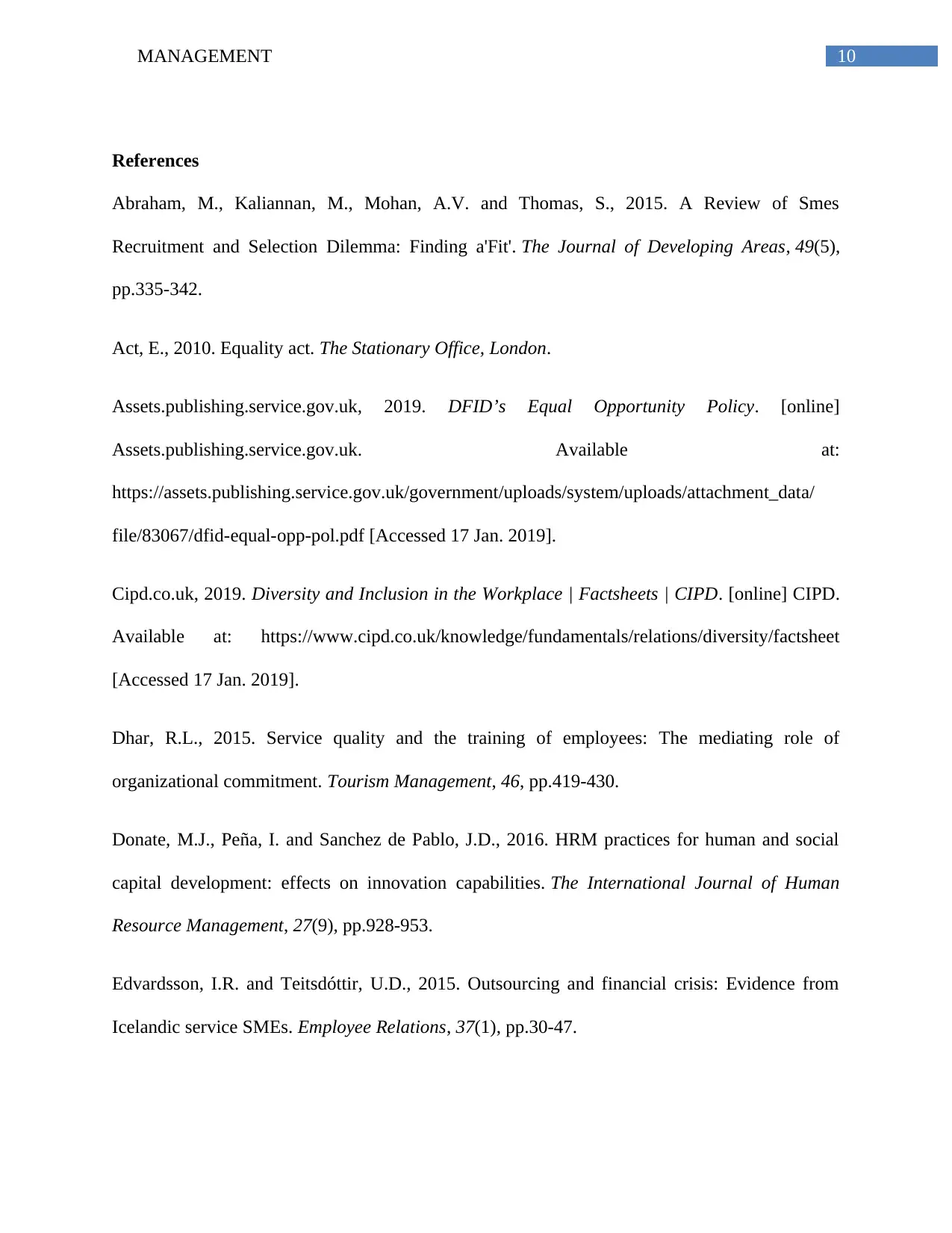
10MANAGEMENT
References
Abraham, M., Kaliannan, M., Mohan, A.V. and Thomas, S., 2015. A Review of Smes
Recruitment and Selection Dilemma: Finding a'Fit'. The Journal of Developing Areas, 49(5),
pp.335-342.
Act, E., 2010. Equality act. The Stationary Office, London.
Assets.publishing.service.gov.uk, 2019. DFID’s Equal Opportunity Policy. [online]
Assets.publishing.service.gov.uk. Available at:
https://assets.publishing.service.gov.uk/government/uploads/system/uploads/attachment_data/
file/83067/dfid-equal-opp-pol.pdf [Accessed 17 Jan. 2019].
Cipd.co.uk, 2019. Diversity and Inclusion in the Workplace | Factsheets | CIPD. [online] CIPD.
Available at: https://www.cipd.co.uk/knowledge/fundamentals/relations/diversity/factsheet
[Accessed 17 Jan. 2019].
Dhar, R.L., 2015. Service quality and the training of employees: The mediating role of
organizational commitment. Tourism Management, 46, pp.419-430.
Donate, M.J., Peña, I. and Sanchez de Pablo, J.D., 2016. HRM practices for human and social
capital development: effects on innovation capabilities. The International Journal of Human
Resource Management, 27(9), pp.928-953.
Edvardsson, I.R. and Teitsdóttir, U.D., 2015. Outsourcing and financial crisis: Evidence from
Icelandic service SMEs. Employee Relations, 37(1), pp.30-47.
References
Abraham, M., Kaliannan, M., Mohan, A.V. and Thomas, S., 2015. A Review of Smes
Recruitment and Selection Dilemma: Finding a'Fit'. The Journal of Developing Areas, 49(5),
pp.335-342.
Act, E., 2010. Equality act. The Stationary Office, London.
Assets.publishing.service.gov.uk, 2019. DFID’s Equal Opportunity Policy. [online]
Assets.publishing.service.gov.uk. Available at:
https://assets.publishing.service.gov.uk/government/uploads/system/uploads/attachment_data/
file/83067/dfid-equal-opp-pol.pdf [Accessed 17 Jan. 2019].
Cipd.co.uk, 2019. Diversity and Inclusion in the Workplace | Factsheets | CIPD. [online] CIPD.
Available at: https://www.cipd.co.uk/knowledge/fundamentals/relations/diversity/factsheet
[Accessed 17 Jan. 2019].
Dhar, R.L., 2015. Service quality and the training of employees: The mediating role of
organizational commitment. Tourism Management, 46, pp.419-430.
Donate, M.J., Peña, I. and Sanchez de Pablo, J.D., 2016. HRM practices for human and social
capital development: effects on innovation capabilities. The International Journal of Human
Resource Management, 27(9), pp.928-953.
Edvardsson, I.R. and Teitsdóttir, U.D., 2015. Outsourcing and financial crisis: Evidence from
Icelandic service SMEs. Employee Relations, 37(1), pp.30-47.
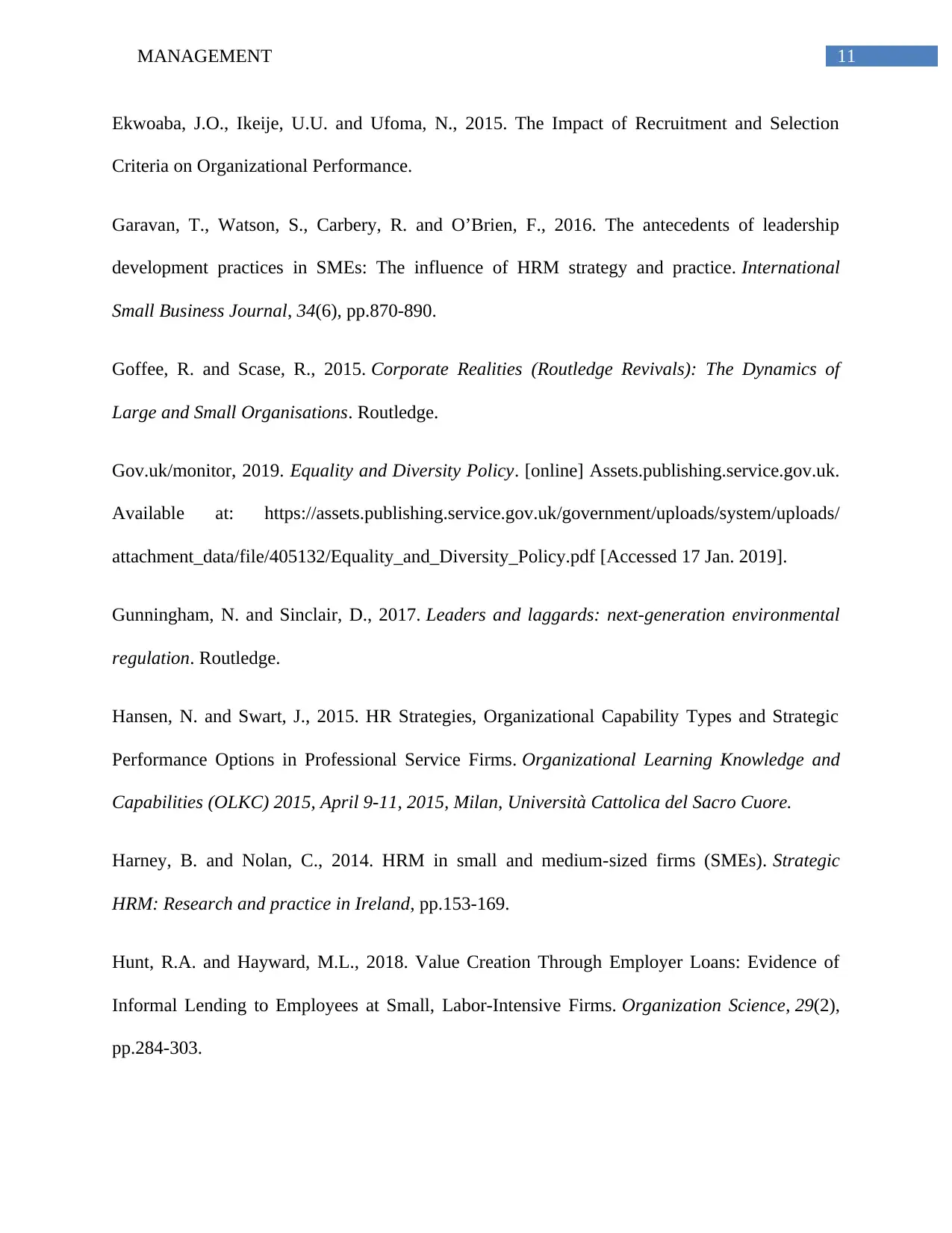
11MANAGEMENT
Ekwoaba, J.O., Ikeije, U.U. and Ufoma, N., 2015. The Impact of Recruitment and Selection
Criteria on Organizational Performance.
Garavan, T., Watson, S., Carbery, R. and O’Brien, F., 2016. The antecedents of leadership
development practices in SMEs: The influence of HRM strategy and practice. International
Small Business Journal, 34(6), pp.870-890.
Goffee, R. and Scase, R., 2015. Corporate Realities (Routledge Revivals): The Dynamics of
Large and Small Organisations. Routledge.
Gov.uk/monitor, 2019. Equality and Diversity Policy. [online] Assets.publishing.service.gov.uk.
Available at: https://assets.publishing.service.gov.uk/government/uploads/system/uploads/
attachment_data/file/405132/Equality_and_Diversity_Policy.pdf [Accessed 17 Jan. 2019].
Gunningham, N. and Sinclair, D., 2017. Leaders and laggards: next-generation environmental
regulation. Routledge.
Hansen, N. and Swart, J., 2015. HR Strategies, Organizational Capability Types and Strategic
Performance Options in Professional Service Firms. Organizational Learning Knowledge and
Capabilities (OLKC) 2015, April 9-11, 2015, Milan, Università Cattolica del Sacro Cuore.
Harney, B. and Nolan, C., 2014. HRM in small and medium-sized firms (SMEs). Strategic
HRM: Research and practice in Ireland, pp.153-169.
Hunt, R.A. and Hayward, M.L., 2018. Value Creation Through Employer Loans: Evidence of
Informal Lending to Employees at Small, Labor-Intensive Firms. Organization Science, 29(2),
pp.284-303.
Ekwoaba, J.O., Ikeije, U.U. and Ufoma, N., 2015. The Impact of Recruitment and Selection
Criteria on Organizational Performance.
Garavan, T., Watson, S., Carbery, R. and O’Brien, F., 2016. The antecedents of leadership
development practices in SMEs: The influence of HRM strategy and practice. International
Small Business Journal, 34(6), pp.870-890.
Goffee, R. and Scase, R., 2015. Corporate Realities (Routledge Revivals): The Dynamics of
Large and Small Organisations. Routledge.
Gov.uk/monitor, 2019. Equality and Diversity Policy. [online] Assets.publishing.service.gov.uk.
Available at: https://assets.publishing.service.gov.uk/government/uploads/system/uploads/
attachment_data/file/405132/Equality_and_Diversity_Policy.pdf [Accessed 17 Jan. 2019].
Gunningham, N. and Sinclair, D., 2017. Leaders and laggards: next-generation environmental
regulation. Routledge.
Hansen, N. and Swart, J., 2015. HR Strategies, Organizational Capability Types and Strategic
Performance Options in Professional Service Firms. Organizational Learning Knowledge and
Capabilities (OLKC) 2015, April 9-11, 2015, Milan, Università Cattolica del Sacro Cuore.
Harney, B. and Nolan, C., 2014. HRM in small and medium-sized firms (SMEs). Strategic
HRM: Research and practice in Ireland, pp.153-169.
Hunt, R.A. and Hayward, M.L., 2018. Value Creation Through Employer Loans: Evidence of
Informal Lending to Employees at Small, Labor-Intensive Firms. Organization Science, 29(2),
pp.284-303.
⊘ This is a preview!⊘
Do you want full access?
Subscribe today to unlock all pages.

Trusted by 1+ million students worldwide
1 out of 14
Related Documents
Your All-in-One AI-Powered Toolkit for Academic Success.
+13062052269
info@desklib.com
Available 24*7 on WhatsApp / Email
![[object Object]](/_next/static/media/star-bottom.7253800d.svg)
Unlock your academic potential
Copyright © 2020–2025 A2Z Services. All Rights Reserved. Developed and managed by ZUCOL.





